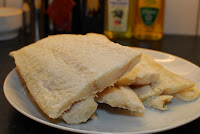"So, Bjørn. What do you think of this newfangled bacalao dish that Diego made for us?"
"Ja vel, I don't know, Knut. It's a bit fancy pants. Maybe it needs some potatoes and brown sauce."Well, by the end of the century, Spanish bacalao would become relatively popular in North West Norway. In fact, it is still eaten today by some on Christmas Eve. However, its popularity never really spread to the rest of the country and it has remained a somewhat exotic dish.
In much the same way that different grades of wine exist, there are five different grades of salt cod in Norway. In descending order of quality these are: Superior Extra, Superior, Imperial, Universal, and Popular. Between January and March each year, millions of cod migrate from the Barents Sea to Norway's northwest coastline to spawn. This spawning cod is known as skrei, and it has been a valuable commodity since the Vikings started trading it in the tenth century. Skrei is cod in its prime, full of energy and vitality, and it is from line-caught skrei that the very best, Superior Extra, klippfisk is made. The skrei is first filleted and then salted and dried twice, in much the same way as a Parma ham, which results in a dense, meaty, and richly flavoured klippfisk.
Contrary to its name, salt cod should not taste overly salty. In order to render salt cod edible it must first be soaked in plenty of water for 24-48 hours depending on the salting method and thickness of the fillets, with the water changed 2-3 times during this period. Over this time the dried fish will soak up the water and magically swell to almost its original size. It then needs to be poached gently, which will result in wonderfully firm, pearl white flesh that doesn't taste overly fishy.
This simple recipe for klippfisk is adapted from a recipe I found in one of my favourite cookbooks, "Big Flavours & Rough Edges", by David Eyre and the cooks at the legendary Eagle pub in Clerkenwell, London. I think the addition of paprika gives the dish a wonderful smokiness, and the tinned tomatoes add some welcome moisture as well as a touch of acidity. Be careful with the seasoning as it probably won't need much, if any, salt to be added. A simple green salad and a large glass of fruity red Rioja would be perfect accompaniments.
Ingredients (Serves 4-6):
- 800g Klippfisk (Salt Cod) soaked for 24hrs
- 2 large onions, sliced
- 4 garlic cloves, finely chopped
- 2 green peppers, sliced
- 1 (400g) can chopped tomatoes
- 10-15 waxy new potatoes, peeled and quartered
- 2 bay leaves
- Juice of 1 lemon
- Chopped flat-leaf parsley
- 1 teaspoon sweet paprika
- 4 tablespoons black olives
- 3 vine-ripened tomatoes, sliced
- 3 hard-boiled eggs, sliced
- 6 tablespoons olive oil
- Black Pepper
- Before using the salt cod you need to soak it to remove the salt. The time it takes to do this varies, but generally 24 hours should do it. Soak the fish in a big bowl cold water and leave in the fridge, making sure to change the water a couple of times.
- Put the soaked cod into a pan of simmering water and cook for 15 minutes until the fish flakes
- When cooked, remove any bones, toss the fish in a little of the olive oil and set aside
- Fry the onions until soft and golden in an oven-proof pan.
- Add the garlic, green peppers, and paprika and cook for a further 2-3 minutes
- Meanwhile, put the potatoes in a pan of cold water and bring to the boil. Simmer for 5 minutes
- Drain the potatoes and add to the onions and peppers. Add the bay leaves, lemon juice, a handful of chopped parsley, the salt cod, can of tomatoes, and some black pepper. Gently mix.
- Cook in the oven at 200ºC for 30 minutes.
- Remove from the oven and sprinkle over the olives and tomatoes.
- Cook in the oven for a further 5 minutes
- Placed the sliced boiled eggs on top, scatter over another handful of chopped parsley and drizzle with olive oil.
- Serve hot with the obligatory bowl of green salad




Hei,
ReplyDeleteJeg sett på engelsk tv i går en programme av the hairy bikers i norge. Hairy bikers, jo, er beromte TV-chefs her i England.
Jeg sett på engelsk tv i går en programme av the hairy bikers i norge. Hairy bikers, jo, er berømte TV-chefs her i England. Så som noen som er engelsk og meget glad i norge, var jeg meget interessert å se dem laget klippfisk suppe, fordi jeg har aldri spist klippfisk i norge, men familien min are fra Jamaica, og folk fra der spise klippfisk ofte.
Lete på internet funnet jeg siden din og klippfisk recipe fra The Eagle. I pleid å spise på Eagle nesten hver uke når bodde jeg i London, men aldri hatt klippfisk. Så skal jeg laget recipe og les siden din nå alltid.
Tussen takk
Min norske er ikke bra så jeg håpe du kan forstå
sherbertboy1@yahoo.com
You mention that "Big flavors and rough edges" are among your favorite cookbooks. What other books would you recommend to a beginner of sorts? I really have enjoyed all books by James Peterson, any other recommendations?
ReplyDeleteHi Norvezhets, I have tons of cookbooks, but I always seem to come back to Nigel Slaters' books. His recipes are usually fairly simple but very tasty.
Delete